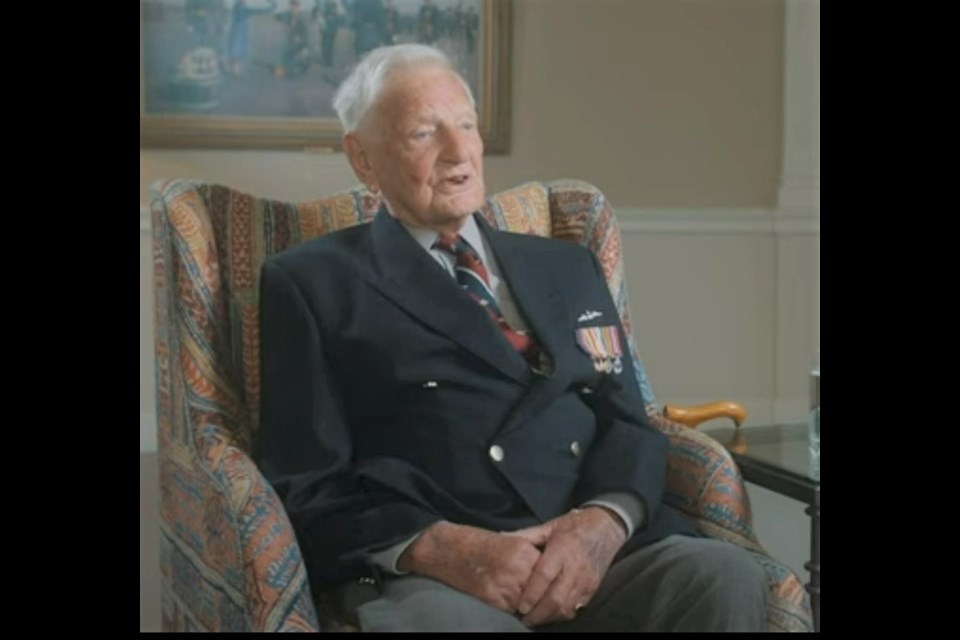A Moose Jaw-born pilot has been featured in a British documentary that recounts his life and what it was like flying one of the most feared warplanes during the Second World War.
Preservation group Hawker Typhoon RB396 and Redison Productions teamed up to film Bernard Gardiner speaking about his war experiences on April 16 at the RAF Club in London, England, as part of celebrations to honour the veteran, who turned 100 on April 6.
Gardiner has joined the group to support its project to rebuild the world’s only genuine Hawker Typhoon airplane. The group believes Gardiner is one of only three living Typhoon pilots from the Second World War.
The group recently released the film on its YouTube page.
Visit hawkertyphoon.com or its Facebook page for more information.
Moose Jaw origins
Gardiner was born in Moose Jaw in 1922, but the family moved to Gloucester, England when he was four years old because his mother couldn’t stand the climate. It was there that his interest in flying began.
The first plane in which Gardiner flew as a youth was a three-engine biplane called an Airspeed Fairy, which was demonstrated during the Sir Alan Cobham Flying Circus. Later, as a teen, he attended an air club demonstration in Cottswald, where his boss was the club’s chief flight instructor.
“He gave me a free flight in a Gypsy Moth, which was a great thrill for me,” laughed Gardiner.
Enlisting in the air force
The Second World War erupted when Gardiner was 18, so he volunteered and was sworn in on Oct. 3, 1940, during an enemy air raid in London.
He received his initial training in Blackpool and was supposed to be shipped to Canada for more training through the British Commonwealth Air Training Plan. However, a German submarine sunk his troop ship, so he was sent to South Africa instead.
Gardiner enjoyed flying on the Tiger Moths, a plane that changed his career. He was supposed to become an airman on a bomber, but he learned to practice solo loops in fighter planes from Royal Air Force manuals, which impressed his instructor.
“… he said, ‘Do that again (loops).’ So I did it again and hit the slipstream and he said, ‘You’re for fighters,’” recalled Gardiner. “So my whole career changed from then on … .”
After acquiring his wings in 1941, he was shipped back to England to train on the Hawker Hurricane. He noted that the Hurricane was easy to fly — “It was a great thrill” — because it had the famous Merlin engine.
He never flew the famous Spitfire, but 80 years later, the preservation group help him fulfill that wish.
Impressing the ladies
During one training session of flying at 200 feet, he attempted to impress army women below by demonstrating the Hurricane’s abilities. However, he overshot their position and slammed into a hawthorn bush that was “oddly enough” 200 feet tall.
“Anyway, I spent quite a bit of time the next few days sitting underneath the Hurricane, picking bits of hawthorn out of the radiator,” Gardiner chuckled. “So I was confined to barracks for a fortnight (two weeks), I think, and was also committed to going to clean aeroplanes rather than go flying.”
A Typhoon approaches
By 1943 the Allies had withdrawn the Hurricane, which forced all pilots to briefly train on the Typhoon. Gardiner converted to the plane, which was the same size as the Hurricane but heavier and better armed.
However, engineers were still working out glitches, including an engine that regularly seized up, vibrations that broke off the tail, and troubles with the fuel lines. Meanwhile, pilots were told not to fly faster than 527 miles per hour.
“Although quite frequently, and in a dive on a target, I saw my airspeed indicator was indicating about 550 mph, (so) the aeroplane seemed to stand it,” the veteran laughed.
First operation
His first operation found him accompanying his flight commander as his wingman. As his leader fired on enemy positions below, Gardiner’s plane flew through a cloud of expended ammunition shells that stuck to his wings. This didn’t impress his flight commander, so Gardiner joked that he never flew with the man again.
By 1944 the German air force had all but disappeared, so Gardiner rarely saw enemy planes. The only aircraft he saw and attacked was a flying boat attempting to take off from a water bay.
“And with a squadron of war-hungry Typhoons above, that was a rather foolish operation. It was his very last flight,” smiled Gardiner.
Supporting the troops
Allied armies rarely called on the air force for support as they moved into Germany in early 1945. However, during the initial invasion, Gardiner’s squadron provided close support to protect Dakota planes towing gliders.
Gardiner’s unit began bombing railway lines in the Netherlands because the Germans were using them to transport to the coast V1 “doodle bugs” and V2 rockets to launch at London. The squadron also worked to knock down the world’s first operational cruise missiles by flying in front of them and interrupting the autopilot.
“And it would lose control and spin and crash to the ground, hopefully without causing too much trouble down there,” chuckled Gardiner.
Gardiner’s last mission was on May 3, 1945, so from then until after the war ended on May 8, he and his squadron practised aerobatics and formation flying, which thoroughly impressed the defeated Germans.
He was later demobilized and sent home.


.png;w=120;h=80;mode=crop)

